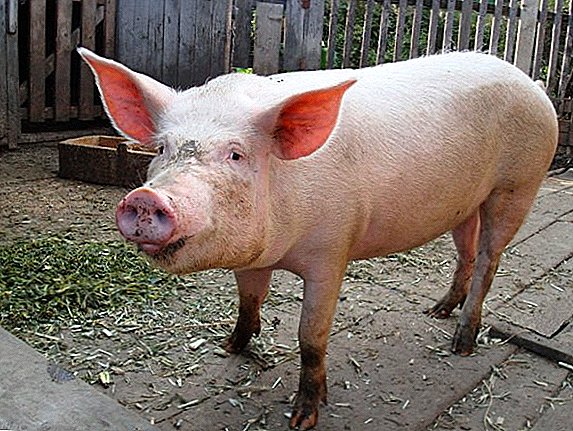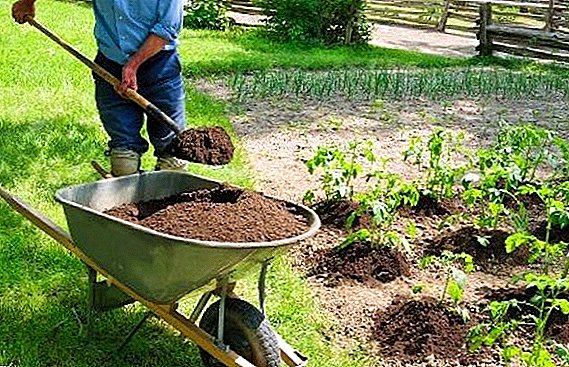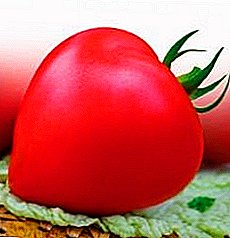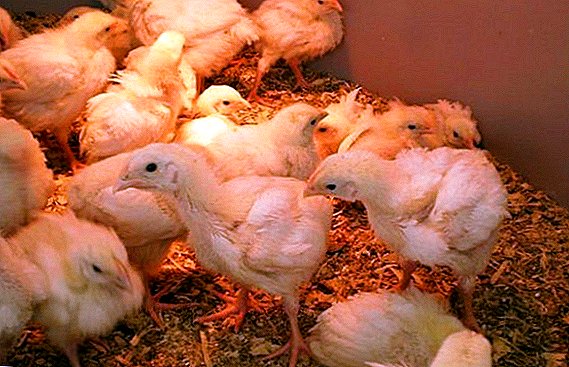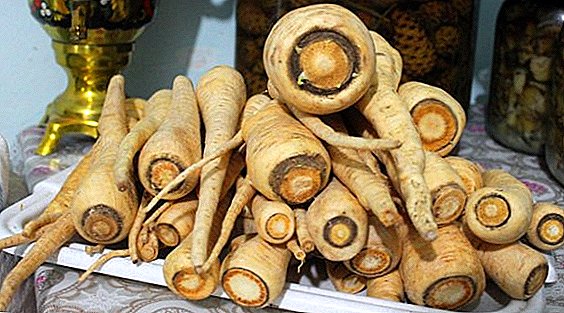 Like many other plants, parsnip has long been famous for its useful and even healing properties. This led to the presence of many ways of its preparation. Parsnip recipes will be of particular interest to people suffering from diseases of the heart, blood vessels and organs of the digestive system. In addition, the specified plant acts as a diuretic and is the first assistant for colic, and some people often use it even to prevent baldness.
Like many other plants, parsnip has long been famous for its useful and even healing properties. This led to the presence of many ways of its preparation. Parsnip recipes will be of particular interest to people suffering from diseases of the heart, blood vessels and organs of the digestive system. In addition, the specified plant acts as a diuretic and is the first assistant for colic, and some people often use it even to prevent baldness.
Such a variety of applications of parsnip caused the need for its proper storage in the winter, so the ways of harvesting this miracle plant we will discuss later.
Dried parsnips
In today's world there are a large number of various options for storing vegetables, fruits or berries, but the oldest and most proven is drying. Even our grandmothers were preparing for the winter in this way, so when answering the question: "How to prepare a parsnip for the winter?" should start with it.
After digging up the required amount of root crops in the fall, they are thoroughly washed under cold running water (even the smallest grains of sand must be removed), cut into small circles (several millimeters thick) and laid out in one layer for drying. There are several ways of drying. Some housewives prefer to dry the parsnip in the oven, others leave it on a well-lit window-sill, and still others simply place the billet in a spacious wall cabinet for long-term drying.
 If you decide to perform drying in the oven or microwave, then be sure to monitor the temperature (it should not be too high), because the circles can simply burn. The oven door is best left open, constantly stirring the root. It is not necessary to bring the process to the end, because a slightly dried parsnip can "walk" perfectly at room temperature.
If you decide to perform drying in the oven or microwave, then be sure to monitor the temperature (it should not be too high), because the circles can simply burn. The oven door is best left open, constantly stirring the root. It is not necessary to bring the process to the end, because a slightly dried parsnip can "walk" perfectly at room temperature.
The process of drying a plant without an oven will take longer but the quality of the final product may be higher. So, leaving the parsnips to dry in the sun, you will have more time to control the process.
After the plant has the desired appearance, it can be sent back into the oven and thoroughly heated, and after it cools completely, it will only be necessary to fold the blank into a clean glass container and put it in a dark cabinet.
Important! To prevent the food moth from starting in dried root crops, it is better to close the cans tightly with airtight lids: metal or plastic.
If you suddenly begin to doubt as a dried parsnip, in the middle of winter you can get it out of the cans and dry it again in a preheated oven (10 minutes will be enough). So you can get rid of not only dampness and mold, but also to destroy possible pests.
The total storage time of a dried plant should not exceed one year, since over time, parsnips lose their healing properties (dried root vegetables contain vitamins, mineral salts, sugars and easily digestible carbohydrates).
Parsnip Frost
 Recently, the easiest and most affordable way of harvesting fruits for the winter (including parsnip) has become their freezing. At first glance, there is nothing difficult in this process, however, each culture has its own subtleties.
Recently, the easiest and most affordable way of harvesting fruits for the winter (including parsnip) has become their freezing. At first glance, there is nothing difficult in this process, however, each culture has its own subtleties.
For example, before proceeding to freezing parsnips, it must be thoroughly washed, peeled and thoroughly dried. After that, the fruit is cut into small cubes, the size of which depends on how you plan to use the plant. If in the future soups will be made from it, then it is better that the cubes are 1-1.5 cm * 1-1.5 cm or the parsnip is cut into strips 0.5-1 cm thick.
In the case when frozen parsnip eventually turns into a puree, it should be frozen with castors or large pieces. If desired, you can experiment with the curly cutting of the root.
Sliced parsnips are laid in freezer bags and tightly closed, after releasing excess air from there.
Important! All the pieces should be distributed in a package with a maximum of two layers, otherwise it will be difficult to achieve fast and high-quality freezing.
Frozen vegetables can be used the next day, taking the right amount of cubes out of the bag.
Frozen parsnips are used both for making soups or mashed potatoes, as well as for creating favorite sauces or as a component of salads.
Parsnip Pickle
 If you are more accustomed to messing with preservation, then we suggest you pickle parsnips. To complete this task for one kilogram of root vegetables, you will need 250 grams of salt and vegetable oil without a distinct smell. First, wash and peel the root thoroughly and allow it to dry completely.
If you are more accustomed to messing with preservation, then we suggest you pickle parsnips. To complete this task for one kilogram of root vegetables, you will need 250 grams of salt and vegetable oil without a distinct smell. First, wash and peel the root thoroughly and allow it to dry completely.
Next, cut it into small pieces or strips (as in the previous version), mix with salt and spread on sterilized jars. On top of the cutting impose a piece of cloth and pour oil so that it covers the contents of the container 10-15 mm. Now it remains only to hermetically close the banks and place them in a dark cool place.
Soup dressing
Those housewives who prefer parsnip soups should like the method of harvesting the plant as a dressing for first courses. In this case, in addition to your favorite root vegetables, you also need parsley, dill and celery, which are thoroughly washed, peeled, dried and cut into pieces, 4-6 cm long. A total of 600 grams of salt per kg of green.
 Carrots (it is also often used for dressing), celery and parsnips should be grated, add salt, mix well and put into small pasteurized jars, well sealing the contents with a spoon. Then each jar is covered with parchment paper and stored in a refrigerator.
Carrots (it is also often used for dressing), celery and parsnips should be grated, add salt, mix well and put into small pasteurized jars, well sealing the contents with a spoon. Then each jar is covered with parchment paper and stored in a refrigerator.
Did you know? The characteristic peculiar smell of the plant is a consequence of the presence in its composition of the octylbutyl ester of butyric acid.
Parsnip Sauce
Most often, housewives use one of the above methods of storing parsnips, however, it is possible to prepare a plant for the winter, by making a sauce out of it. For 500 g of root vegetables, you will need 200 g of tomato juice or paste, 50 ml of sunflower oil (you can use olive oil), 100 ml of vinegar and 2 teaspoons of salt. Some spices should also be prepared - a few bay leaves and carnations.
For a start, the parsnip itself is washed under running water, then placed in boiling water and cooked over medium heat until it becomes soft. As soon as the vegetable reaches the desired condition, it is taken out and whipped with a blender (you can use a sieve, but in this case the process will take much more time from you). After that, the resulting mass is poured into the pan, add all remaining ingredients and leave on the fire for half an hour, stirring occasionally, so that it does not burn.
 After this time, the parsnips are whipped again until smooth, and the resulting sauce is poured over pasteurized jars, plugging them. Before serving, it is better to add a little sunflower oil, sour cream or broth.
After this time, the parsnips are whipped again until smooth, and the resulting sauce is poured over pasteurized jars, plugging them. Before serving, it is better to add a little sunflower oil, sour cream or broth.
Did you know? In ancient times, parsnip was used as one of the main means for initiating sexual activity, increasing appetite, as a painkiller for liver, kidney and stomach cramps, as well as in the fight against hallucinations.
Any of the above methods of preparation will provide you with enough vitamins in the winter, because such a useful parsnip will always be at hand.



